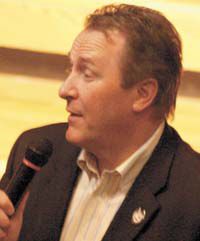| Mark Shurtleff |
County Republicans met last Friday to confirm the party’s local candidates and hear from state officials concerning the upcoming general election and the issues facing Utah.
The convention at Mont Harmon Junior High saw Jae Potter and Gerald Lloyd receive the Republican nominations in the county commission races.
Potter is running for the position currently occupied by Mike Milovich and Lloyd is seeking the seat to be vacated by Steven Burge.
David Hinkins was endorsed as the local candidate for the Utah Senate. However, his formal nomination will have to come at the state level.
Jerry B. Anderson has filled for the local seat in the Utah House.
Following the selection of candidates, state representatives from the governor’s and attorney general’s offices spoke to the group.
Attorney General Mark Shurtleff commented on the issue of polygamy and the current legal battle in Texas.
“In my time as attorney general, we have always gone after men who have used religious beliefs and dogma to abuse women and children,” said Shurtleff. “But they have gone too far in Texas. We won’t take polygamists’ children away just because they are polygamists.”
As of April 25, Texas had retained custody of the 437 children seized from polygamists of the fundamentalist LDS faith. The children were taken from families and placed in state care due to allegations of sexual abuse.
Texas must now find temporary foster homes for the children, who range in age from infants to teens. The state has started conducting DNA tests to link the children to specific adults.
According to Bloomberg.com, Texas has placed 138 of the children and the rest remain at the San Angelo Coliseum, a sports stadium 40 miles north of the religious group’s compound in Eldorado
Sticking with children’s issues, Shurtleff turned to Internet pornography and Utah’s success in dealing with this national epidemic.
Utah leads the nation in the conviction of Internet predators and child pornographers and the prosecution of Warren Jeffs also sent a strong message, according to the attorney general.
“We will not tolerate the abuse or neglect of any children in Utah,” noted Shurtleff.
Utah also was one of the first states to institute an Amber Alert policy and the first to create an endangered person advisory.
“Both systems have become models for the nation,” said Shurtleff.
Since the beginning of the Amber Alert, 21 Utah children have been returned home safely. The program is a voluntary, cooperative partnership between law enforcement agencies and local broadcasters to send emergency alerts to the public when a child has been abducted and believed to be in grave danger.
The public is notified through flyers, electronic signs, pagers and other means. Under the plan, radio and television stations interrupt programming to broadcast information about the missing child using the Emergency Alert System, formerly known as the Emergency Broadcast System.
In closing, Shurtleff addressed the battle Utah law enforcement has waged against methamphetamine use and production since he took office.
The number of methamphetamine labs seized in Utah jumped from four in 1990 to 266 in 1999 for an increase of 6,650 percent.
Utah also ranks third nationally in the percentage of males and second for the percentage of females arrested who tested positive for meth.
Before 2000, Utah had the second highest number of meth labs per capita in the nation.
After hundreds of arrests and years of increased law enforcement presence and tactics, Utah now ranks among the lowest.
Along with strong law enforcement measures, the attorney general’s office has fought the production of meth by encouraging retailers to monitor the sale of certain products and educating the public about how the drug is produced.
“The processing required to make methamphetamine from precursor substances is easier and more accessible than ever. An investment of a few hundred dollars in over-the-counter medications and chemicals can produce thousands of dollars worth of methamphetamine,” states the attorney general’s website
The drug can be produced in a makeshift lab that can fit into a suitcase. Some intelligence figures suggest that the average meth cook teaches 10 other people how to make the drug each year.
Over-the-counter medications containing ephedrine or pseudoephedrine, red phosphorous, hydrochloric acid, drain cleaner, battery acid, lye, lantern fuel and antifreeze are among the ingredients most commonly used, according to the attorney general’s website.

